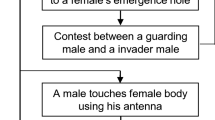Abstract
Males of the hermit crab Pagurus filholi perform precopulatory guarding behavior, and solitary males often show aggressive behavior to take away guarded females. Males behave coercively while guarding females, so direct mate choice by females seems difficult in such a situation. By performing several experiments we examined possible indirect female choice of hermit crab. Males were attached to a shell by their left cheliped to look like guarding pairs (fake guarding pairs). The shells were filled with cotton containing either seawater or pheromone water. The fake guarding pair with only seawater caused male–male combat in 60% of trials whereas with pheromone water combats occurred in 88% of trials. Mean duration of male–male combat was significantly longer in trials with drops of seawater containing pheromones than in those without pheromones. These results suggest guarding pairs themselves cause male–male combat by visual stimulation, that female sex pheromones have further significant function in the recognition of guarding pairs and intensification of male–male combat, and that females release sex pheromones while they are guarded. As a result of the combat, the larger male ended up guarding a female. This strongly suggests that females choose males indirectly by exploiting male–male competition induced by sex pheromones under male coercive behavior.




Similar content being viewed by others
References
Arnqvist G, Rowe L (2005) Sexual conflict. Princeton University Press, Princeton
Berrill M, Arsenault M (1982) Mating-behavior of the green shore crab Carcinus maenas. Bull Mar Sci 32:632–638
Christofferson JP (1978) Evidence for the controlled release of a crustacean sex pheromone. J Chem Ecol 4:633–639
Goshima S, Koga T, Murai M (1996) Mate acceptance and guarding by male fiddler crabs Uca tetragonon. J Exp Mar Biol Ecol 196:131–143
Goshima S, Kawashima T, Wada S (1998) Mate choice by males of hermit crab Pagurus filholi: do males assess ripeness and/or fecundity of females? Ecol Res 13:151–161
Goshima S, Minouchi K, Yoshino K, Wada S (2006) Size assortative mating by the hermit crab Pagurus filholi (Decapoda: Anomura: Paguridae). In: Biology of Anomura II. Crust Res special no. 6:87–94
Imafuku M (1986) Sexual discrimination in the hermit crab Pagurus geminus. J Ethol 4:39–47
Jormalainen V (1998) Precopulatory mate guarding in crustaceans: male competitive strategy and intersexual conflict. Q Rev Biol 73:275–304
Jormalainen V, Merilaita S, Riihimaki J (2001) Costs of intersexual conflict in the isopod Idotea baltica. J Evol Biol 14:763–772
Kamio M, Reidenbach MA, Derby CD (2008) To paddle or not: context dependent courtship display by male blue crabs, Callinectes sapidus. J Exp Biol 211:1243–1248
Koga T, Murai M, Goshima S, Poovachiranon S (2000) Underground mating in the fiddler crab Uca tetragonon: the association between female life history traits and male mating tactics. J Exp Mar Biol Ecol 248:35–52
Krebs JR, Davies NB (1993) An introduction to behavioral ecology, 4th edn. Blackwell, Oxford
Maan ME, Groothuis TGG, Wittenberg J (2001) Escalated fighting despite predictors of conflict outcome: solving the paradox in the South American cichlid fish. Anim Behav 62:623–634
Minouchi S, Goshima S (1998) Effect of male/female size ratio on mating behavior of the hermit crab Pagurus filholi (Anomura: Paguridae) under laboratory conditions. J Crust Biol 18:710–716
Reid DG, Abello P, Warman CG (1994) Size-related mating success in the shore crab Carcinus maenas (Crustacea, Brachyura). J Zool 232:394–407
Sneddon LU, Huntingford FA, Taylor AC, Clare AS (2003) Female sex pheromone-mediated effects on behavior and consequences of male competition in the shore crab (Carcinus maenas). J Chem Ecol 29:55–70
Thorpe KE, Taylor AC, Huntingford FA (1995) How costly is fighting? Physiological effects of sustained exercise and fighting in swimming crab Necora puber (L.) (Brachyura, Portunidae). Anim Behav 50:1657–1666
Wiley RH, Poston J (1996) Indirect mate choice, competition for mates, and coevolution of the sexes. Evolution 50:1371–1381
Yamanoi T, Yoshino K, Kon K, Goshima S (2006) Delayed copulation as a means of female choice by the hermit crab Pagurus filholi. J Ethol 24:213–218
Yoshino K, Goshima S, Nakao S (2002) Temporal reproductive patterns within a breeding season of the hermit crab Pagurus filholi: effects of crab size and shell species. Mar Biol 141:1069–1075
Yoshino K, Ozawa M, Goshima S (2004) Effects of shell size fit on the efficacy of male guarding behaviour in male hermit crabs. J Mar Biol Assoc UK 84:1203–1208
Acknowledgments
We thank S. Wada, T. Kawaminami, and other members of the Laboratory of Marine Biology and Biodiversity, Graduate School of Fisheries Sciences, Hokkaido University, for their help and advice with the field sampling and experiments. We also thank R.C. Lombardo for improving the English text.
Author information
Authors and Affiliations
Corresponding author
About this article
Cite this article
Okamura, S., Goshima, S. Indirect female choice mediated by sex pheromones in the hermit crab Pagurus filholi . J Ethol 28, 323–329 (2010). https://doi.org/10.1007/s10164-009-0188-2
Received:
Accepted:
Published:
Issue Date:
DOI: https://doi.org/10.1007/s10164-009-0188-2




